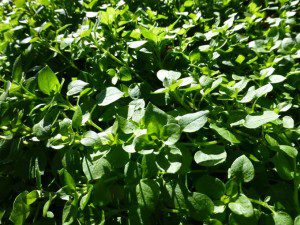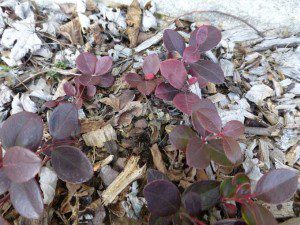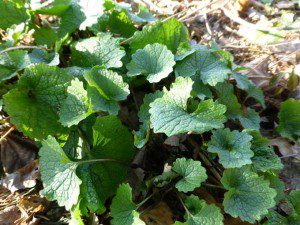There are signs of wild edible plants and cultivated varieties popping up all over the garden but before I shift my focus to spring I wanted to share a few of the edible weeds that have been out there for the picking all winter long. Despite the presence of frozen soils and blankets of snow, some wild edible plants remain lush and green even through repeated freezes and thaws.
The milder winters may be making it easier than ever to keep hardy greens growing but you can’t always count on picking garden fresh veggies like lettuce and kale year-round. That’s why it’s great to have a backup plan of wild edible plants to forage on during the coldest times of year.
Hardy Chickweed Provides Greens for Winter Salads
 Looking around this winter I was surprised to see a lush stand of chickweed in late January that looked no different than you would expect to see during springtime. Chickweed is one of my favorite wild edible plants and it goes great in everything from salads to smoothies; the flavor is very mild and chickweed is also reputed to have some medicinal qualities.
Looking around this winter I was surprised to see a lush stand of chickweed in late January that looked no different than you would expect to see during springtime. Chickweed is one of my favorite wild edible plants and it goes great in everything from salads to smoothies; the flavor is very mild and chickweed is also reputed to have some medicinal qualities.
There was also lots of chickweed visible this winter along local hiking trails. This is a great edible weed to learn and identify. As with any wild edible plant, be positive of your identification, harvest from areas that are free of pollution and pesticides, be alert to any allergies or sensitivities that you may have, and don’t over harvest to the point that the plant will not be able to survive and multiply naturally.
Wintergreen takes on a Whole New Appearance
Another wild edible that caught my attention this winter was the wintergreen. In this case the plants weren’t so wild after all because they are ones that I planted as an understory in the blueberry beds. But wintergreen is a common native plant that can be found growing throughout Pennsylvania. It produces a small amount of berries and has edible leaves, but those with any sensitivity to aspirin should not snack on wintergreen plants.
they are ones that I planted as an understory in the blueberry beds. But wintergreen is a common native plant that can be found growing throughout Pennsylvania. It produces a small amount of berries and has edible leaves, but those with any sensitivity to aspirin should not snack on wintergreen plants.
What drew me to the wintergreen in my garden this winter was the color of its leaves. Where they are a waxy green during the growing season, my plants retained all of their leaves but they had turned a rich shade of deep red for the winter season. I would guess that the change in color also reflected a change in the nutritional or medicinal properties that would be contained in the leaves during this time.
Enjoying the Wild Flavors of Winter’s Landscape
After chewing a few of the leaves I discovered that despite the change in appearance, they had retained that distinctive minty, wintergreen flavor that most of us are familiar with. The plants are doing very well in the beds and have grown significantly since they were planted last season. Most of the new growth is above ground but the plants also send out underground runners.
 Both the chickweed and wintergreen can be foraged long after the cultivated edibles have pretty well disappeared from the garden. Even a blanket of snow and ice will not stop either of these wild plants. I’m sure there are others like garlic mustard and various varieties of cresses which you can also locate on winter landscape.
Both the chickweed and wintergreen can be foraged long after the cultivated edibles have pretty well disappeared from the garden. Even a blanket of snow and ice will not stop either of these wild plants. I’m sure there are others like garlic mustard and various varieties of cresses which you can also locate on winter landscape.
A basic knowledge of a handful of wild edible plants is a nice bonus for the backyard gardener to possess, and spring is a great time to start down that path of learning to identify some new edible weeds.



5 Responses
Thanks I will tell my wife about these plants and growing. Was interesting reading your bio as well. Like your site!
Rodney, http://restlesshandswithmanyplans.blogspot.com/
Interesting article on the the edible weeds as I’ve never new they can be eaten. I bet their packed with potent benefits of nutrient that can be much healthier than what we see in commercial stores.
“A basic knowledge of a handful of wild edible plants is a nice bonus for the backyard gardener to possess, and spring is a great time to start down that path of learning to identify some new edible weeds.”
It is indeed, a backyard gardener should know this information about edible weeds.
Hi David, yes weeds are more important and valuable than many of us realize and one person’s weed is another’s dinner.
Great post. Growing up in New York, I remember chewing on all kinds of plants with different flavors. We just kind of knew what we could eat. I only started cooking with them recently.